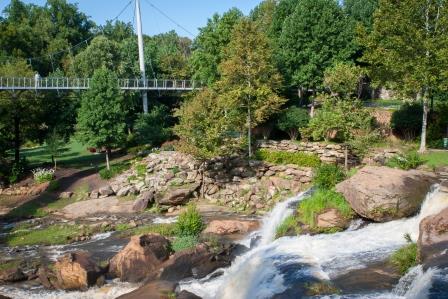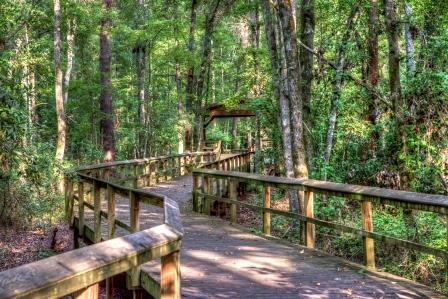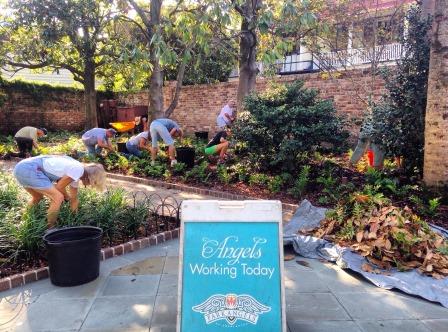Parks serve numerous purposes in a community including connecting people with nature, providing social gathering spots, helping the environment and offering health benefits from physical activity. While active parks such as playgrounds and ball fields may offer the most obvious physical benefits, passive parks, with their benches, trails or greenspace, also play an important role in the community’s well-being.

Falls Park/Photo: City of Greenville
In Greenville, Falls Park is the picturesque epicenter of the downtown and provides an oasis for a variety of users. The park provides a welcoming space where downtown employees, visitors and local residents gather to work, play, picnic, read a book or just sit quietly to enjoy the natural beauty in one of its gardens.
"Falls Park has set the standard for future public space by providing a seamless alignment between architecture, art and nature," said Dale Westermeier, deputy director of parks and recreation for the City of Greenville. "Additionally, it has served as a model for future park development by providing a guiding principal for public and private partnerships. The Carolina Foothills Garden Club, Furman University, corporations and individuals all played a role by providing an endowment, property, sponsorships and other enhancements."
Falls Park hosts a wide array of activities and events, including Shakespeare in the Park, Artisphere, the Reedy River Duck Derby, the Chautauqua festival, and numerous concerts and gatherings. The park has generated more than $100 million in economic development with projects including residential, office, retail, hotels, restaurants and mixed-use development.
This has revitalized Greenville’s West End, Westermeier said. The park’s development transformed a once desolate and neglected space into an urban oasis complete with gardens and visually stunning waterfalls and vistas, he said.
Greenville realized the beauty of its natural resources—the Reedy River and falls—had the potential to draw visitors and play a role in economic development, said Jim Headley, executive director of the SC Recreation and Parks Association.
"Every single community across the state has its own Falls Park," Headley said. "They all have something unique in their own backyard."
For the residents of Walterboro, their backyard contains a 600-acre unspoiled preserve containing four miles of boardwalks, and hiking, biking and nature trails. This habitat for more than 80 species of birds and other abundant wildlife is protected by the Walterboro Wildlife Sanctuary. Its strategic location near I-95 also makes it an inviting destination for vacationers looking for family-friendly entertainment, said Walterboro City Manager Jeff Molinari.

Walterboro Wildlife Sanctuary/Photo: Jeff Kramer
"The Sanctuary serves as a major economic force for Walterboro, creating a demand for expanded tourism amenities such as high-quality hotels, restaurants and shops," he said.
The city’s park system helps promote a healthy environment for residents and visitors alike, Molinari said.
"Parks greatly enhance the quality of life in Walterboro by providing opportunities for exercise and social interaction, and helping to revitalize neighborhoods," he said. "City parks also play an important role in beautification which creates a welcoming environment for visitors."
Work began in Charleston in 2007 to increase the quality, awareness and usage of the city’s parks and greenspaces with the founding of the Charleston Parks Conservancy. Businesswoman and philanthropist Darla Moore founded the group which works closely with the City of Charleston Parks Department and an active group of volunteers.
"The impact has been incredible by bringing citizens back to their parks," said Jason Kronsberg, Charleston’s deputy director of parks. "This re-engagement has resulted in an elevated level of park beautification and park maintenance by giving people a renewed sense of pride and ownership in their parks."
Individuals dubbed "park angels" and "aqua angels" volunteer in the parks, working with and learning from the conservancy’s horticulturalist. This learning also takes place in one of the three existing community gardens that the Conservancy operates in city parks, Kronsberg said.

Charleston's Park Angels/Photo: Charleston Parks Conservancy
Charleston has more than 120 parks and athletic complexes spanning the peninsula to the neighborhoods of West Ashley, Johns Island, James Island and Daniel Island. Parks in the historic district provide visitors with an activity to pass the time between tours or before dinner. The city’s waterfront parks offer visitors and residents a place to take in the view, catch a cool breeze or go fishing.
"The value of parks and open space is immeasurable based on the enjoyment provided for the people and the benefits to the environment," Kronsberg concluded.
Those environmental benefits are plentiful. Parks provide a habitat for birds and animals. They can filter stormwater before it enters the drainage system. A mature tree canopy provided by parks can cool the hot surfaces of rooftops, concrete roads and parking lots in a city, reducing the urban heat island effect. Trees in parks also can help improve air quality by reducing pollutants caused by traffic and other sources.
Studies have shown that the property values are higher—as much as 20 percent—for homes located near passive parks. Many people are willing to pay more for a house located near a park. The higher values mean the owners contribute more to the tax base.
With the many benefits (environmental, economic and health), "cities really have a responsibility to invest in parks," Headley said.
